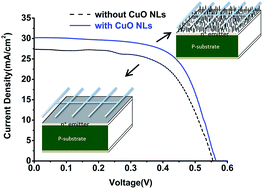CuO nanoleaves enhance the c-Si solar cell efficiency
Abstract
Various-sized arrays of CuO nanoleaves (NLs) were fabricated on a pyramid-textured c-Si wafer. The CuO NL/c-Si solar cells show a great increase of the optical absorption and a reduction of the reflectance in the 250–1250 nm wavelength range, compared to the reference one. The c-Si solar cell integrated with CuO NLs generates the graded index of refraction between the surface of Si and air, and improves the light utilization efficiency by increasing the light-trapping effect and forming resonant optical modes, which leads to multiple scattering of the incident light. In addition, the deposition of p-type CuO NLs on the surface of the Si wafer can form a CuO NL/c-Si junction and generate a built-in potential, which is beneficial for the separation of photogenerated electrons and holes, leading to the minority carrier lifetime (τeff) increase from 5.7 to 15.0 μs. The CuO NL/c-Si structure reduces the optical loss, improves the carrier collection, and distinctly enhances the c-Si solar cell efficiency. The experimental results indicate that short-circuit current and power conversion efficiency of CuO NL/c-Si solar cells increase by 10.30% and 17.90%, respectively. The CuO NL/c-Si structure is expected to exceed the Shockley–Queisser limit of the single junction solar cells.


 Please wait while we load your content...
Please wait while we load your content...